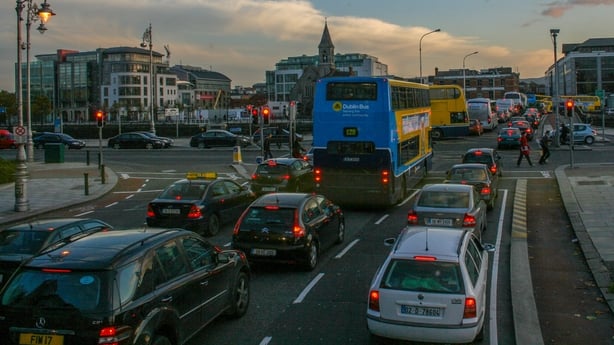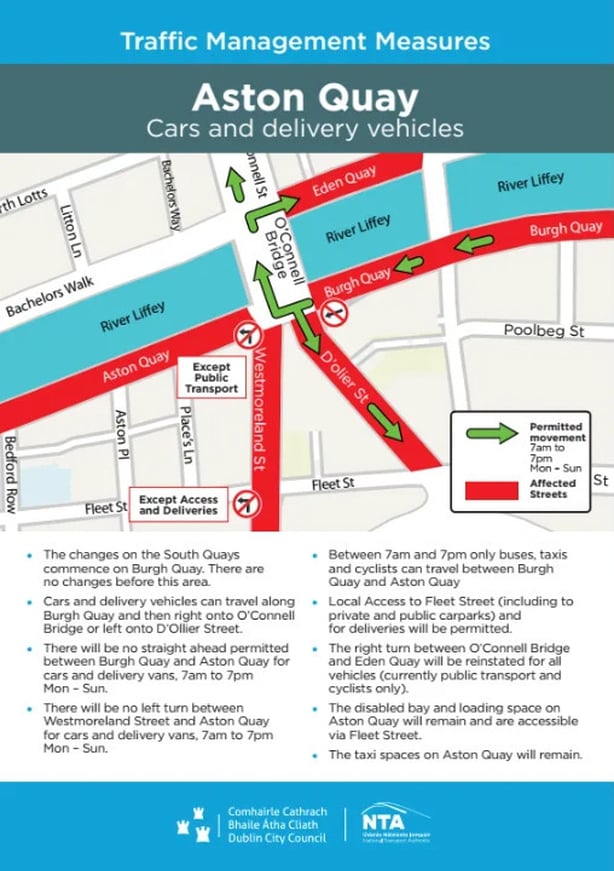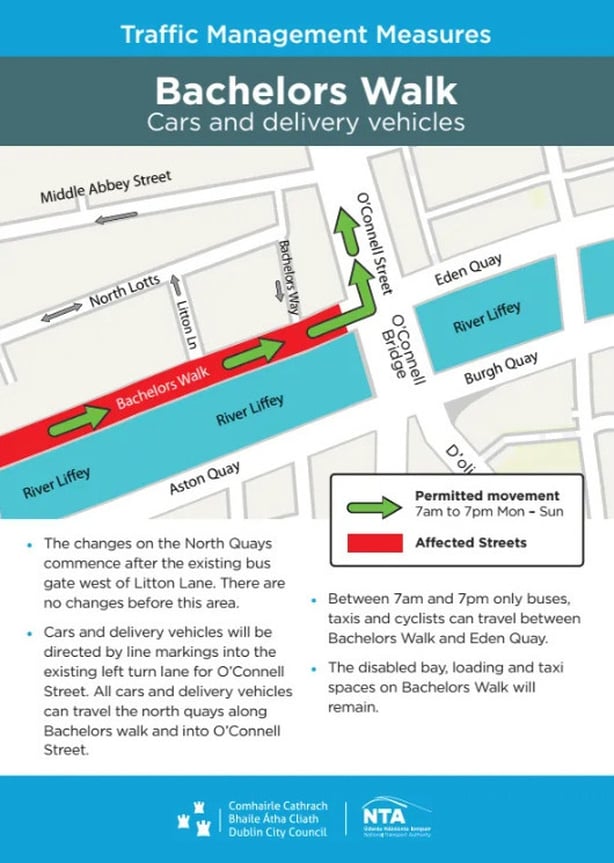Vladimir: Well what do we do?
Estragon: Don't lets do anything. It’s safer
Dubliner Samuel Beckett may have written those words in his 1949 work Waiting for Godot, but 75 years on, there were echoes of those lines from the Dubliner’s most famous play in the debate over the introduction of the transport plan for the capital which comes into effect today.
Last month, Dublin City Council’s Chief Executive Richard Shakespeare decided to proceed with the plan which will see bus gates introduced on sections of the north and south quays of the Liffey, despite dire warnings from some city centre businesses, the threat of legal proceedings and an unexpected ministerial intervention.
While the new measures will change the way people travel around the city, they have been significantly scaled back from the plan that was mooted earlier this year.
The concept of a bus gate first came into Irish public discourse in April 2009, when Dublin City Council proposed introducing a ban on private cars using College Green, to discourage cross-city travel.
Back then, the proposal proved hugely controversial with estimates that it could result in the loss of 2,500 jobs and €200 million in revenue for city centre traders.
At the time, David McCormack of the Dublin City Centre Businesses Association said: "Potentially the message could go out that there’s difficulty getting to Dublin.
"What we need to do is reassure our customers and everyone in Dublin that the city remains open for business."
His colleague Tom Coffey said he believed 70% of retail business came from car shoppers, who he said would now go elsewhere if they could not travel around the city.

Opponents of the 2009 plan said Dublin City Council should delay implementing the College Green bus gate until infrastructural improvements had been made to the capital including the opening of the Samuel Beckett Bridge, which was as still a few months away.
They also suggested pausing the plans to see what work would be required for the construction of Metro North.
The College Green bus gate began later that year on a phased basis, with bus gates operating from 7am to 7pm Monday to Friday before being changed to a 24/7 restriction in May 2023.
The predicted job and revenue losses never materialised and even before its full implementation, a report by the National Transport Authority in 2015 said the College Green Bus gate has had a "significant impact on bus reliability".
If the council had bowed to calls to pause that plan 15 years ago, they would still be waiting to find out what work would be required for Metro North.
Fast forward to Autumn 2023 and an almost identical debate began when the draft Dublin Transport Plan was first published.
It proposed sweeping changes to the way traffic could travel around the capital's core with bus gates on the quays, restrictions on private vehicles travelling in particular directions around the city centre and the pedestrianisation of some areas, all with a view to reducing the number of cars that travel through Dublin city centre without stopping there, which the council said accounted for about 60% of motor journeys.
A public consultation was held between September and December 2023.
More than 3,500 submissions were received by the council and they said there was "overwhelming support for the vision set out in the City Centre Transport plan".
However, as the plan edged closer to implementation, the reaction from some retailers and city centre businesses had echoes of 2009.
In May 2024, the employers group IBEC called for the implementation of the plan paused and for an examination of their potential impact to be carried out.
Next came the Dublin City Traders Alliance calling for a pause.
Its members which included Retail Excellence Ireland, the Restaurants Association of Ireland, a number of car park owners and the retailers Arnotts and Brown Thomas produced an economic assessment saying the traffic restrictions could result in the loss of 1,700 jobs and €141m in retail sales.
Then the newly appointed Minister of State for Enterprise Emer Higgins made a surprise intervention asking the council to postpone the introduction of the plan until spring 2025 citing concern for jobs and businesses.
However her Government colleague, Minister for the Environment Eamon Ryan, said the plan must proceed and suggested that Dublin City Council could lose funding if the introduction of the measures was delayed.
The Plan
Last month, Dublin City Council announced they would plough ahead with the first phase of the plan from today but the changes were scaled back from what had been originally outlined.
Bus gates will operate from 7am to 7pm Monday to Sunday on the north quays at Bachelors Walk and on the South Quays on Burgh Quay and Aston Quay.
Road marking and signage changes will allow private cars and delivery vehicles travelling on the north quays from Bachelor's Walk to take a left turn up O’Connell Street with only buses, taxis and cyclists permitted to proceed onto Eden Quay.

On the south quays, cars and delivery vehicles travelling along Burgh Quay will be directed to turn right onto O’Connell Street or left onto D’Olier Street with only buses taxis and cyclists allowed to travel straight onto Aston Quay.
There will also be no left turn from Westmoreland Street and Aston Quay for cars and delivery vans 7am to 7pm Monday to Sunday.
There will be local access to Fleet Street in Temple Bar for car park access and deliveries the right turn between O’Connell Bridge and Eden Quay which is currently only for public transport and cyclists will be reinstated.
Dublin City Council has said that outside of the 7am to 7pm restriction, all vehicles can travel as before and that there are no changes to disabled bays, loading bays and taxi ranks and that the vast majority of routes to hospitals and city centre car parks will remain the same.
It said access for residents will be maintained but there may be a different route to or from the area.
It said the traffic management measures aim to address the fact that 60% of general traffic in the city centre is not stopping, working or shopping but is simply travelling through the city.
The council said it has been in touch with Sat Nav providers and Google Maps to ensure that their systems are carrying the up-to-date restrictions and that they will have people on the ground to monitor the impact of the changes and respond where necessary.
Introducing these measures on a Sunday in late August means their full effect will not be felt for at least a week or two after the summer holiday period is over and school-related traffic returns.
Lord Mayor James Geoghegan will chair a working group to monitor the impact of the changes and that group is due to have its first meeting in two weeks time.
Retail Excellence Ireland (REI) said it was "regrettable" that Dublin City Council resisted calls for the plan to be paused.

It said it welcomed the establishment of the working group but said the plan must be revisited if businesses in the city see a marked reduction in retail spending as a result of the new plan.
REI CEO Jean Mc Cabe said: "It is regrettable that retailers have not been adequately consulted on this new plan and that it does not address our concerns around deliveries, public transport capacity and projected retail spend as a result of limiting car journeys into the city.
"We appreciate that the plan for the city has to start somewhere and there is no easy fix, but it is critically important that industry feedback is noted and acted on if we see a significant drop in retail spend as a result of these changes."
During the public consultation period on the plan, the drinks giant Diageo also raised concerns about the measures.
It said that 75% of the beer it produces in St James's Gate travels down the quays to Dublin Port for export to 150 countries worldwide.
In its submission, it said that alternative routes from St James’s Gate to Dublin Port would lead to transport emissions increasing by up to 927 additional tonnes of CO2 per annum.
It also said that two of the three alternative routes identified routing HGVs along Church Street and Drumcondra Road or Infirmary Road and North Circular Road would lead to substantially increased road safety risks through residential areas in the north city.
It is understood that while there have been talks on finding a solution to facilitate Ireland's most famous export, no agreement has been reached to date.
Suggestions that the company could transport its goods for export between 7pm to 7am are said not to be viable because as it operates in a residential area, Diageo cannot move delivery trucks late in the evening.
A spokeswoman for Diageo said: "While the concerns highlighted in our submission still stand, and as 75% of the beer produced at St James’s Gate is exported to more than 150 countries around the world - we will continue to assess the most appropriate and efficient routes from St James’s Gate to Dublin Port as the Dublin City Transport Plan comes into effect."
However transport experts believe the time is right for a change to Dublin city centre traffic.
Brian Caulfield, Professor in Transportation at the Centre for Transport Research in Trinity College Dublin, said although the impact of this first phase of the plan has been scaled back from what was originally envisaged, he believes the council were right to introduce even limited measures "not letting perfection be the enemy of the good".
He said: "97% of people that travel will not be impacted. One of the key elements of introducing this new arrangement is to facilitate bus movements and improved journey times.
"59% of the people that travel in this area during the bus gate times do so by bus.
"Overall, this first phase should see a reduction in bus travel times and an improvement in air and noise quality.
"It will be important that the City Council measures the improvements in travel times and reports these to the general public."
Prof Caulfield also said that in the long term the traffic plan needs to work.
He said: "Ultimately in Dublin we have a growing population of people and cars that is putting pressure on our current transport networks and in order to facilitate these increased numbers radical change needs to happen.
"The amount of street space that we have for moving people around our city is not increasing with population growth.
"Therefore, street space becomes a valuable commodity and moving people more efficiently through it using public transport is the most logical option.
"What's happening in Dublin is also happening in many cities around the world. We need to urgently and rapidly increase the provision of public transport services and finally start construction on projects we've been talking about for decades."
The wait continues for better transport infrastructure in the capital, including the further roll-out of Bus Connects and the commencement of the Metrolink project.
The coming weeks will reveal if pressing ahead with the transport plan brings positive change to Dublin’s public transport or results in the pain predicted by some businesses.
Either way, Dublin City Council has decided that when it came to tackling the capitals traffic issues, doing nothing was not the safer option. How this phase of the plan goes will be closely monitored and is likely to determine when and if future parts of the plan can come into force.
Dublin City Council officials will be hoping that the first phase is without incident and that, unlike Beckett’s tragicomedy, they will not have an interminable wait, before the next stages can be introduced.






